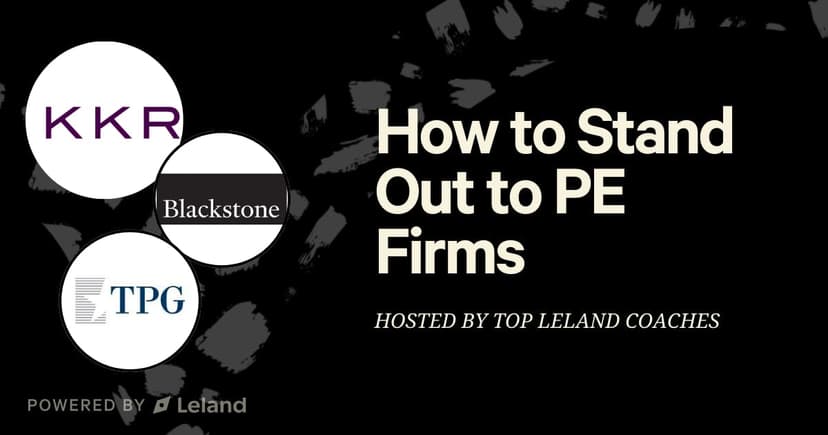Paper LBO for PE Interviews: Model Walkthrough, Examples, & Practice (2025)
Master the paper LBO with our expert guide—step-by-step examples, pro tips, and practice prompts to ace your private equity interview.
Posted August 13, 2025

Join a free event
Learn from top coaches and industry experts in live, interactive sessions you can join for free.
Table of Contents
Nailing the paper LBO in a private equity interview isn’t just about getting the math right but about showing you can think, communicate, and solve problems like an investor.
In this guide, we’ll walk through exactly how to tackle a paper LBO from start to finish: clarifying transaction assumptions, modeling free cash flow (FCF), using lightning-fast IRR shortcuts, and presenting your analysis with the polish that wins offers. By the end, you’ll have a repeatable system you can use in any interview, under any time pressure.
Read: Intro to Financial Modeling – With Examples (2025)
What Is a Paper LBO and Why It Matters in Private Equity Interviews
A paper LBO is a pen-and-paper (or whiteboard) version of the leveraged buyout model. Instead of a full Excel build, interviewers give you a paper LBO prompt with simplified numbers and ask you to calculate the deal’s returns — usually exit equity value, IRR, and key leverage metrics — in your head or with minimal math aids.
It’s a staple of private equity interviews because it reveals whether you can think like an investor:
- Quickly identify transaction assumptions
- Estimate free cash flow and levered free cash flow
- Decide on the right amount of debt financing and sponsor equity
- Communicate your rationale clearly
Most private equity firms, and especially the top funds, will include some variation of a paper LBO exercise in final-round or superday assessments. Top private equity firms see it as the best “pressure test” for judgment, mental math, and communication.
Key Concepts You Must Master Before You Start
Before you complete a paper LBO, be fluent in these concepts — they appear in nearly every paper LBO example:
| Term | Why It Matters |
|---|---|
| Enterprise Value | Purchase price for the whole company, including debt. |
| Equity Value | Value attributable to equity holders after subtracting net debt. |
| Exit Equity Value | Equity value at sale — critical for IRR and MOIC. |
| Exit Enterprise Value | Sale price for the whole company before debt repayment. |
| Purchase Price / Purchase Multiple | How much you pay (often stated as a multiple of LTM EBITDA). |
| Free Cash Flow (FCF) | Cash available after capital expenditures, interest, and taxes. |
| Levered Free Cash Flow | FCF after servicing debt — drives debt paydown and investor returns. |
| Interest Expense | Cost of debt, driven by interest rate and debt balance. |
| Net Working Capital | Operational liquidity — changes here affect cash flows. |
| Debt Schedule | Timetable for repayments, balances, and remaining debt. |
Paper LBO Format
While some interviewers may give you calculation aids such as a basic calculator or limited Excel functionality, you should never rely on them. The majority of paper LBO exercises are designed to see how you think, communicate, and prioritize under time pressure, not how fast you can type formulas into a spreadsheet.
In most cases, the interviewer wants to watch you work through the problem out loud. They’re evaluating whether you can structure your approach, make reasonable assumptions, and explain your math in a clear, logical sequence. This is as much a communication test as it is a technical one.
Use a clean, repeatable structure like the ASICR flow (Assumptions → Statement [Income Statement/FCF] → IRR/MOIC → Conclusion → Risks) as you work. This helps you cover every step without skipping critical details and keeps your explanation organized for the listener.
Expect anywhere from 5 to 20 minutes for the full exercise that includes both your calculations and your verbal walkthrough. In faster-paced final rounds, you might have as little as 5–7 minutes; in longer, more technical settings, you could be given the full 20 minutes to dig deeper into sensitivities and risks.
As part of your preparation, practice in realistic conditions. Time yourself. Speak every step aloud as if you were in the room with the interviewer. Record yourself and review both the clarity of your math and the confidence of your delivery. The goal is to sound like someone who could present a deal in an investment committee meeting tomorrow.
Step-by-Step: How to Complete a Paper LBO in an Interview
This framework is interview-tested and can be done in under 10 minutes.
1. Clarify Transaction Assumptions
The first thirty seconds of a paper LBO set the tone. Before making a single calculation, confirm the core inputs: purchase price, purchase multiple, LTM EBITDA, and any net working capital requirements. Pin down the capital structure, including the amount of debt financing, equity financing, and the sponsor equity contribution. Ensure you understand the debt terms, including the interest rate, repayment schedule, and whether amortization is required, as well as the expected holding period and exit multiple that will determine the exit enterprise value.
Pro Tip: In a 10x LTM EBITDA scenario, multiply EBITDA by 10 to get purchase enterprise value — then adjust for cash-free debt basis.
2. Build a Mini Income Statement
In a paper LBO interview, the prompt might look something like this:
You are acquiring a company with $200 million in revenue and a 25% EBITDA margin. Purchase price is based on a 10x LTM EBITDA multiple. The deal will be financed with $400 million in debt at a 5% interest rate. Depreciation & amortization (D&A) is $10 million per year. The tax rate is 25%.
Even without Excel, you can project revenue and expenses to calculate EBITDA margin by year. The goal here is to isolate the drivers of free cash flow and returns — not to build a fully detailed model.
Step-by-step calculation for Year 1 using the prompt above:
- Revenue: $200M (given in the prompt)
- EBITDA: Apply the EBITDA margin (25%) → $200M × 25% = $50M EBITDA
- Taxable Income: Subtract non-cash expenses (D&A = $10M) → $50M – $10M = $40M
- Taxes: Apply the 25% tax rate → $40M × 25% = $10M taxes
- EBT (Earnings Before Taxes): $40M – $10M = $30M
- Interest Expense: Calculate interest expense = $400M debt × 5% = $20M
- Net Income: $30M – $20M = $10M
This simplified income statement shows the interviewer that you can quickly bridge from revenue to net income using only the numbers provided in the paper LBO prompt. By keeping figures in round millions, you save time and make it easier to communicate results under pressure.
3. Estimate Free Cash Flow (FCF)
Use the free cash flow calculation:
EBITDA – CapEx – Change in Net Working Capital – Taxes – Interest Expense = Free Cash Flow
The bridge from operating results to investor returns is your free cash flow calculation. Take EBITDA and subtract capital expenditures, the change in net working capital, taxes, and interest expense to arrive at free cash flow (FCF). Track both unlevered free cash flow, which reflects the company’s operating health, and levered free cash flow, which shows how much cash is available after servicing debt. Summing the annual levered free cash flows gives you cumulative free cash flow — the amount available for debt repayment over the hold period. Interviewers often probe how sensitive returns are to changes in working capital or CapEx, so be ready to address those points.
4. Model Debt Paydown
Start with the debt balance at close and reduce it each year by the amount of levered free cash flow generated. Keep track of the remaining debt before exit, as this figure directly impacts the exit equity calculation. While modeling, state whether the paydown is linear or weighted toward certain years, as this demonstrates an understanding of how debt schedules work in real deals.
5. Calculate Exit Equity Value & IRR
At exit:
Exit Equity Value = Exit Enterprise Value – Remaining Debt + Cash Balance
From there, determine the multiple on invested capital (MOIC) by dividing the exit equity value by the initial sponsor equity. For a quick IRR calculation, use mental math shortcuts like the Rule of 72 or Rule of 114.
For example, a 2.0x MOIC over five years translates to roughly a 15% IRR. If the interviewer specifies the same multiple exit, tie your math back to the purchase enterprise value; if there are multiple expansions or contractions, call out their effect on returns explicitly.
6. Present Your Findings
The final presentation should sound like a deal recommendation, not a math recital. Begin with a concise setup that states the purchase price, leverage ratio, and key transaction assumptions. Summarize free cash flow generation, debt paydown, and the resulting exit equity value. Highlight the MOIC and IRR alongside the two or three main drivers of those returns, such as EBITDA growth, multiple expansion, or deleveraging. Conclude by briefly mentioning the major risks to the thesis, for example, macroeconomic headwinds or margin pressure, to show that you can think like an investment professional. Interviewers aren’t just testing your calculations; they’re gauging whether you could represent the deal confidently in front of an investment committee.
Work 1-on-1 with a Leland coach who’s run private equity interview superdays. They’ll grade your paper LBO exercise, refine your transaction assumptions, and give you insider-level prep so you can walk into your next interview ready to crush it.
Paper LBO Prompt Example
You are interviewing for an associate role at a mid-market private equity firm. The interviewer hands you the following scenario:
Target Company: JoeCo, a fast-growing specialty coffee roaster.
Financials: JoeCo generated $100 million in the last twelve months (LTM) revenue, with an EBITDA margin of 50% ($50 million LTM EBITDA). Revenue is projected to grow at 10% annually for the next five years, with EBITDA margins remaining stable.
Operating Assumptions: Depreciation & amortization (D&A) is 5% of revenue, capital expenditures (CapEx) are also 5% of revenue, there is no change in net working capital (NWC), and the effective tax rate is 25%.
Transaction Assumptions: The purchase price is based on a 10.0x LTM EBITDA multiple, and the private equity firm plans to exit at the same multiple after a five-year holding period.
Financing Assumptions: Initial leverage is 6.0x EBITDA, with the debt carrying an 8.0% interest rate. There is no required amortization — the entire debt balance will be paid down in full at exit using sale proceeds.
Question: Based on these assumptions, what is the implied internal rate of return (IRR) and multiple on invested capital (MOIC) for the investment?
Why this is a strong practice prompt:
It forces you to calculate purchase enterprise value, sponsor equity, annual free cash flow (FCF), cumulative debt paydown, and exit equity value before working into returns. The same structure — stable margins, modest growth, clean financing terms — is common in real interviews because it tests whether you can:
- Work quickly through a calculate free cash flow bridge.
- Apply mental math to debt paydown and IRR.
- Keep your structure clean without unnecessary complexity.
Step-by-step solution to the JoeCo paper LBO prompt:
1. Calculate Purchase Enterprise Value and Equity Contribution
- LTM EBITDA = $50M
- Purchase Multiple = 10.0×
- Purchase Enterprise Value (EV) = $50M × 10.0 = $500M
- Debt Financing = 6.0× EBITDA = $50M × 6.0 = $300M
- Sponsor Equity = EV – Debt = $500M – $300M = $200M
2. Project Revenue and EBITDA for 5 Years
Revenue grows at 10% per year, and EBITDA margin stays at 50%.
| Year | Revenue ($M) | EBITDA Margin | EBITDA ($M) |
|---|---|---|---|
| 1 | 100.0 | 50% | 50.0 |
| 2 | 110.0 | 50% | 55.0 |
| 3 | 121.0 | 50% | 60.5 |
| 4 | 133.1 | 50% | 66.55 |
| 5 | 146.41 | 50% | 73.205 |
3. Build a Mini Income Statement Each Year
- D&A = 5% of Revenue
- EBIT = EBITDA – D&A
- Interest Expense = $300M × 8% = $24M per year (no paydown until exit)
- Taxes = EBIT × 25%
- Net Income = EBIT – Interest – Taxes
Example for Year 1:
- D&A = $100M × 5% = $5M
- EBIT = $50M – $5M = $45M
- Taxes = $45M × 25% = $11.25M
- Net Income = $45M – $24M – $11.25M = $9.75M
4. Calculate Annual Free Cash Flow (FCF)
Formula: EBITDA – CapEx – Δ NWC – Taxes – Interest Expense
- CapEx = 5% of Revenue
- Δ NWC = 0
- Taxes and interest from above
Year 1 Example:
- CapEx = $100M × 5% = $5M
- FCF = $50M – $5M – $0 – $11.25M – $24M = $9.75M
(Same as net income here because D&A = CapEx and Δ NWC = 0.)
Repeat for each year:
| Year | EBITDA | CapEx | Taxes | Interest | FCF |
|---|---|---|---|---|---|
| 1 | 50.0 | 5.0 | 11.25 | 24.0 | 9.75 |
| 2 | 55.0 | 5.5 | 13.0 | 24.0 | 12.5 |
| 3 | 60.5 | 6.05 | 14.9 | 24.0 | 15.55 |
| 4 | 66.55 | 6.655 | 16.94 | 24.0 | 18.96 |
| 5 | 73.205 | 7.3205 | 19.33 | 24.0 | 22.55 |
5. Exit Enterprise Value and Equity Value
- Exit EBITDA (Year 5) = $73.205M
- Exit Multiple = 10.0×
- Exit Enterprise Value = $73.205M × 10.0 = $732.05M
- Debt is still $300M (no amortization until exit).
- Exit Equity Value = $732.05M – $300M = $432.05M
6. Calculate MOIC and IRR
- MOIC = Exit Equity ÷ Sponsor Equity = $432.05M ÷ $200M = 2.16×
- IRR ≈ Use Rule of 72: 72 ÷ Years to Double = 72 ÷ 5 = 14.4% for 2.0× MOIC. Since MOIC is 2.16×, IRR is slightly higher — about 15–16%.
Final Answer:
- MOIC: ~2.16×
- IRR: ~15–16%
Common Mistakes That Kill Paper LBO Performance
- Overcomplicating the paper LBO with unnecessary detail instead of focusing on the core drivers of returns.
- Failing to define and justify the exit strategy or same multiple assumptions driving the exit enterprise value.
- Ignoring changes in the cash balance that directly affect equity value at exit.
- Not linking net income to actual cash flow drivers like working capital changes, non-cash expenses, and capital expenditures.
- Misjudging purchase enterprise value or exit enterprise value, leading to flawed valuation and return calculations.
Advanced Tips from Real Private Equity Professionals
The best paper LBO candidates don’t just “do the math” — they approach the exercise like an actual deal professional would. Here’s how top-performing candidates stand out in private equity interviews:
Work backwards from your target IRR to frame the deal.
In live deal-making, valuation is often anchored to a required return threshold. In an interview, reverse-engineering the purchase price from a 20% IRR target (for example) shows you’re thinking in terms of investor objectives, not just arithmetic. This also forces you to consider the levers, such as EBITDA growth, multiple expansion, and debt paydown, that would make such a return feasible.
Master mental math shortcuts to save minutes under pressure.
Grouping numbers into clean, easy multiples is a hallmark of seasoned investors. Instead of multiplying $48 million × 11.5 directly, think of it as $50M × 12, then subtract the difference. Pair this with IRR approximations like the Rule of 72 or 114, and you can match the speed of an Excel model without touching a keyboard.
Standardize your paper LBO model layout.
One of the biggest time drains in interviews is rethinking your structure each time. Create a repeatable format: transaction assumptions, income statement, free cash flow, debt schedule, exit math, and use it every time you practice. When the layout is second nature, you can focus mental energy on the numbers and narrative.
Cross-check enterprise value and equity value every year.
Professionals constantly sanity-check their numbers. In a paper LBO, always reconcile enterprise value to equity value by subtracting net debt. This double-check will catch errors in debt paydown, cash build, or working capital swings that could otherwise derail your final IRR.
Bring up working capital and macro risks without being asked.
Many candidates forget that cash generation isn’t just about revenue and margins. Changes in working capital can significantly impact free cash flow and macro factors. Interest rate hikes, GDP slowdowns, and commodity price shocks can make or break a thesis. Mentioning them proactively signals maturity, commercial awareness, and readiness to sit in front of an investment committee.
Practice Makes Perfect
The single most reliable way to get faster and sharper at the paper LBO is deliberate, structured practice. Top candidates don’t just “look at” examples — they simulate the real interview environment repeatedly until their process is second nature.
Start by working through paper LBO examples from high-quality investment banking training or private equity interview prep materials. Don’t just read the solution — actively recreate it under timed conditions, aiming to complete your work in 8–10 minutes. This builds the speed and mental discipline you’ll need in a live setting.
In parallel, practice a full leveraged buyout model built in Excel, then strip it down to a “pen-and-paper” format. This reinforces the link between a full model’s detail and the simplified paper LBO structure, so you can move confidently between the two in interviews.
Expert-Recommended Resources for Practice
- Online PE casebooks — authentic interview prompts from real private equity firms, with return expectations and industry context.
- Mock interviews with coaches — work with former PE professionals who can grade your performance, refine your mental math, and push you to think like an investor.
- Paper LBO models from prior interviews — actual prompts and solutions used in recruiting processes, giving you a realistic benchmark for speed and accuracy.
When you combine timed drills, realistic prompts, and expert feedback, you’ll build not only technical mastery but also the confidence to handle any curveball your interviewer throws at you.
Final Checklist Before Your Interview
Walk into the room knowing you can handle anything the interviewer throws at you. In the last 24 hours before your private equity interview, focus on these essentials:
- Memorize your core formulas — be able to calculate EBITDA, calculate free cash flow, and approximate IRR using shortcuts like the Rule of 72 or 114 without hesitation. In a paper LBO, speed and accuracy are critical.
- Be fluent in key value drivers — understand how capital expenditures, net debt, and purchase multiple assumptions affect enterprise value, equity value, and returns.
- Know your leverage math — be able to explain how the debt to equity ratio changes over the holding period, and why that impacts investor risk and IRR.
- Clarify the valuation basis — always confirm whether the analysis is on a debt-free basis or a cash-free basis, as it changes the equity value calculation and can lead to major mistakes if misunderstood.
If you can confidently run through each of these without notes, you’re positioned not just to pass the paper LBO but to impress your interviewer as someone who already thinks like an investor.
Conclusion: Why Mastering the Paper LBO Gives You an Edge
The paper LBO model isn’t about perfect math — it’s about demonstrating that you think like an investor under time pressure. By mastering the framework, practicing mental math, and presenting with clarity, you’ll separate yourself from the average candidate and show you’re ready to add value at a private equity firm from day one.
If you want to shortcut your learning curve, work with a top private equity coach who’s placed candidates at the top private equity firms. They’ll drill you on paper LBO prompts, review your paper LBO examples, and make sure your approach beats the competition every time. You can also check out private equity bootcamps and free events to unlock your full PE potential!
See: The 10 Best Private Equity Career Coaches for Interview Prep & Training
Read these next:
- Top Skills You Need to Break Into Private Equity
- 50+ Most Common PE Interview Questions & Answers (Behavioral/Technical)
- How to Ace Your Blackstone Interview
- The 10 Best Questions to Ask Your Interviewer in a Private Equity Interview
- Finance Internships for College & High School Students
- The Best Venture Capital & Private Equity Newsletters and Podcasts
- Private Equity Case Study Guide: Example & Practice
- Private Equity Resume Guide (With Template & Example)
FAQs
What’s the easiest way to explain a paper LBO to someone new?
- Think of it as a simplified leveraged buyout you do on paper instead of in Excel. You estimate returns using just a few assumptions, basic math, and a clear structure. The goal is speed and clarity, not perfection.
How do I know what numbers to use in a paper LBO?
- The interviewer will give you a prompt with key details, such as purchase price or multiple, EBITDA, debt terms, tax rate, and maybe growth or CapEx. If something’s missing, ask for it. In real interviews, clarifying assumptions is part of the test.
What’s the fastest way to calculate IRR in a paper LBO?
- Use mental math shortcuts like the Rule of 72 or 114. For example, if your MOIC is 2.0x over 5 years, divide 72 by 5 for a quick ~15% IRR estimate.
How much detail should I show in my paper LBO?
- Only what drives the returns. Show transaction assumptions, a mini income statement, free cash flow, debt paydown, and exit equity value. Don’t build extra schedules you don’t need — you’ll run out of time and risk errors.
What’s the difference between enterprise value and equity value in a paper LBO?
- Enterprise value is the total value of the business (debt + equity). Equity value is what’s left for equity holders after subtracting net debt from enterprise value. The difference matters because equity value is what drives MOIC and IRR.
How can I get better at paper LBOs quickly?
- Time yourself doing realistic prompts. Start with examples from training materials or past interviews, then practice until you can finish in 8–10 minutes. Get feedback from someone who’s worked in PE so you know what’s realistic and what’s overcomplicated.
Browse hundreds of expert coaches
Leland coaches have helped thousands of people achieve their goals. A dedicated mentor can make all the difference.
















